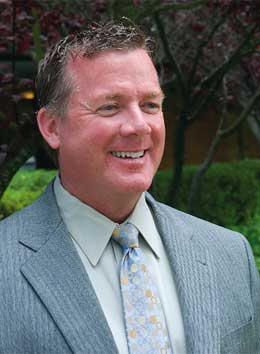|
Hitting the reset button
Starting from scratch, the owners of Vantreo Insurance build a
dynamic new business model
By Elisabeth Boone, CPCU
If you could start your agency all over, what would you do? Which people, goals, and procedures would you keep, and which would you replace? How would you identify and communicate your mission ... your brand ... your objectives and strategies? How would you position yourself in the marketplace ... differentiate yourself from competitors ... and present a compelling value proposition to your prospects and clients?
For the founders of Vantreo Insurance Brokerage in Santa Rosa, California, those questions were no mere pie-in-the-sky exercise. When Lynne Wallace and Tim Chanter, then partners in Matsen Insurance Brokerage, bought a book of business from Matsen’s Santa Rosa office in 2007, they wanted to build a new operation from the ground up.
Wallace, Vantreo’s president, had held that position at Matsen and also was a highly successful commercial lines producer. Chanter, who has more than 40 years’ experience in life, health, benefits, and financial services, had served as president of Matsen Financial Services and is now executive vice president of Vantreo. Steve Farmiloe is chief operations officer of Vantreo; he had been Matsen’s vice president of sales since joining the firm in 2003.
With executive and sales management experience in wholesale distribution, manufacturing, and telecommunications, Farmiloe complements the solid insurance backgrounds of Wallace and Chanter and brings a valuable outsider’s perspective to the creation of an efficient, results-oriented insurance brokerage operation. The three principals are finding their diverse backgrounds to be a significant asset as they develop and implement their blueprint for Vantreo.
What’s in a name?
Among the myriad challenges they confronted in shaping their new venture, the management team understood the critical importance of creating a distinct identity—starting with choosing a name that would reflect their vision and values.
“We wanted to build an organization in which all of our stakeholders could participate,” Wallace says. “If we named it after ourselves, that would be difficult. So we decided to create an entirely new name, and we chose Vantreo. The ‘Van’ comes from ‘vanguard,’ meaning at the forefront of an industry, and the ‘treo’ is a play on the word ‘trio,’ which refers to the vital relationship among the client, the insurance company, and the broker,” Wallace explains. “The two words fit together, because if we are doing our job well, then all of us will be in the vanguard of our industry.”
The concept and symbolism of Vantreo, Wallace observes, “is something our team has really been able to take ownership in. Everybody here understands what Vantreo is about and is committed to creating that experience for our company, our clients, and our insurers.” Forming the nucleus of the Vantreo team are some 20 former Matsen employees, who have brought to the new organization a wealth of experience in all phases of agency operations.
Challenge = opportunity
When it opened for business in 2007, Vantreo not only faced the challenge of creating and communicating a new brand but also had to chart a course through the most severe economic collapse since the Great Depression. Few, if any, of its niche markets were unscathed by the meltdown: construction, real estate, hospitality, health care, professional services, manufacturing, wholesale and retail, and the wine business.
The economic downturn is posing challenges to individuals and businesses throughout the United States, but California, which is also facing an unprecedented budget crisis, has been particularly hard hit. “With 10% unemployment, we knew we had no time to waste in setting our reset button,” Farmiloe says. “The economy gave us the perfect opportunity to do that.
“We decided to concentrate on creating a new company, not just to survive, but to thrive,” he says. “Our focus has been on building a solid foundation that will allow us to achieve superior financial performance, increase productivity, and improve our sales performance and client retention.”
No “business as usual”
To make meaningful progress toward reaching these objectives in the midst of a recession and a prolonged soft market, the Vantreo team knew they couldn’t do business as usual. “The phrase ‘because we’ve always done it that way’ had to go out the window,” Farmiloe declares.
This meant eliminating unnecessary procedures, identifying and cutting out “dead wood” on the staff, and essentially restructuring expectations, he says. “Stop printing and sending out reports, and see who notices,” he suggests. Another time waster is long meetings with no set purpose. “Our meetings now follow a predefined agenda and last no more than one hour,” Farmiloe says.
Before entering the insurance business, Farmiloe had amassed an impressive record of turning failing divisions and organizations into efficient, profitable enterprises. He relished the challenge of finding out what wasn’t working and why, then devising strategies to streamline operations, reduce costs, and motivate employees to commit themselves to working toward shared goals.
Whenever he was given a tough turnaround assignment, Farmiloe says, “I gathered facts and figures. I studied what competitors were doing. I asked questions of our employees, and I listened to the answers.”
Most people want to play on a winning team, he asserts; but entrenched bureaucracies, rigid adherence to outmoded ideas, and fear of change create logjams in what should be smoothly functioning operations.
With the management team in agreement that Vantreo would recognize no sacred cows, Farmiloe says, his first step was to measure the firm’s financial metrics: historic rate of growth; historic retention by line of business; earnings before interest, taxes, depreciation, and amortization (EBITDA); expense ratios; revenue per employee, and employee turnover.
“I compared each of these metrics to industry averages, then identified the areas where corrections were needed,” Farmiloe explains. “We used this information to build a financial model and set goals. Next we developed strategies to improve performance and results in the areas where it was needed, and we communicated our strategies to the entire organization so we could obtain buy-in.”
An important step in structuring Vantreo’s operations was to establish each division as a separate profit center and to develop standard information technology by department. With an eye on the bottom line, the brokerage renegotiated its business loans and equipment leases and restructured its office lease on more favorable terms.
New path for producers
A key area where Vantreo’s principals saw an opportunity to improve performance was in the production of new business. Under the commission structure they inherited, the commission for both new and renewal business was 35%, so producers weren’t being motivated to focus on bringing in new accounts.
“We changed our commission structure to encourage new behavior,” Farmiloe explains. “We now pay producers 70% on net new business and 25% on renewals. We also pay 10% of the first-year commission to any employee who provides a lead that results in new business written.” In the past, he observes, this idea might not have been appealing to producers; with the new commission structure, however, producers are happy to “share the wealth” with employees who provide solid leads to new accounts.
Drawing on his sales management experience in manufacturing, distribution, and telecommunications, Farmiloe also set out to create a dynamic new sales culture at Vantreo.
“Over the years of my career in sales management, I put together a sales coaching curriculum,” Farmiloe says. “The telecom industry, with its heavy reliance on venture capital return on investment, provided the basis for the curriculum design. Sales management in that industry was under intense pressure because of the tight strings associated with venture capital investments.
“I literally had venture capitalists calling me on Wednesday wanting a projection of sales for the next two days,” he continues. “They didn’t allow guessing, that’s for sure,” Farmiloe says with a chuckle. “So for me, a heavy reliance on sales funnel management was fundamental.”
The program Farmiloe developed consists of 28 modules. “The first thing I do is profile each producer,” he says. “Using tests like DISC, Kolbe, SPQ, and Gold, I take a look at the producer’s internal wiring. Then I look at his or her historic rate of growth, personal value proposition, and current niche focus. Next I ask the producer to establish a ‘stretch’ goal. Then we formulate a strategic business plan to deliver those results,” Farmiloe explains.
“As I take the producer through the program, each segment has a predetermined output. Every few modules, we create a new plan document,” he says. “For example, after completing the modules for personal value proposition, company value proposition, and niche opportunities, the producer writes his or her positioning statement and ‘elevator pitch.’”
The module-based curriculum, Farmiloe says, “takes the producer through the modules that will allow him or her to achieve the best results based on the initial profiling. It’s amazing to see the positive attitudes our producers are developing in response to the accountability standards we establish,” he says enthusiastically. “Sometimes producers stay up late or get up early before meeting with me because they don’t want to let me down—actually, let themselves down.”
Looking back over his career, Farmiloe says, “I’ve always been a ‘MapQuest’ ™ kind of business leader. I do the same with our producers. I establish their current position and their desired position and plot a course between the two. In our weekly coaching sessions we develop daily, weekly, and monthly plans. In my experience, the way to build a successful sales management system is to combine three key elements: skills training, discipline, and accountability,” Farmiloe says.
“Sales management is a passion with me,” he continues. “I love helping people achieve success. I believe that every individual wants to be successful and wants to belong to a winning team. Too often a manager will give a producer a sales report, tell him, ‘You’re below your sales objective,’ and push the producer right back out the door.
“That is not sales management,” Farmiloe declares. “Sales management is working alongside the producer and personalizing the coaching to take advantage of his or her strengths, make improvements where needed, and drive top performance and results.”
Speaking of results, Farmiloe says, sales coaching helped a producer who was frustrated with her performance to make an impressive turnaround that has her and her colleagues smiling.
“We began her sales coaching in January,” he says. “This producer is very serious about her sales coaching sessions, and her results prove it. With a combination of skill refinement, accountability, and motivation, she produced more in the first four months of 2009 than she wrote in all of 2008.”
Farmiloe cites another success story, this one the result of his producer profiling process. “We discovered that we had a producer who was passionate about working with nonprofits, so we agreed that she would focus on developing business in that market,” he explains. “We focused her as the head of a newly formed nonprofit division. She believes that, with her knowledge of this market, she is almost able to ‘write a check’ to her nonprofit clients by finding better coverage solutions for them.”
Numbers tell the story
Lofty goals and ambitious initiatives are fine, but what really matters is results. At the end of its first year, Vantreo’s numbers told a story about what can be accomplished by an energetic blend of experience, commitment, focus, and the determination to create a dynamic new business entity.
At the end of 2008, Vantreo had a retention rate of 97%, posted an 18% increase in net new business with 60% of it coming through internal referrals, had 19% EBITDA, and zero turnover.
“What are we achieving today that we didn’t before?” Farmiloe asks.
His answer: “Better financial results, increased productivity, enhanced carrier relationships and contingencies, and happier employees.”
His question to other agency owners: “Is it time for you to hit the reset button? If you don’t, the next owner will.”
|
|
| |
 |
| |
Vantreo executives, from left: Timothy D. Chanter, Executive Vice President; Steve Farmiloe, Chief Operating Officer; and Lynne L. Wallace, CPCU, President. |
| |
 |
| |
“The phrase ‘because we’ve always done it that way’ had to go out the window.”
—Steve Farmiloe
|
| |
 |
| |
“We wanted to build an organization in which all of our stakeholders could participate.”
—Lynne L. Wallace |
|